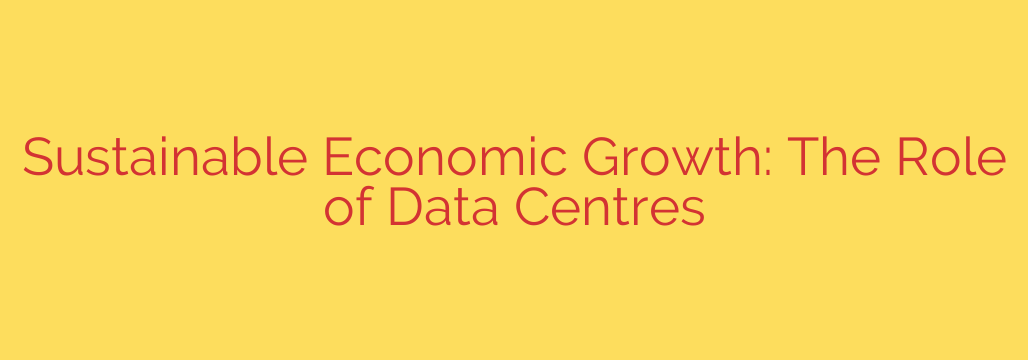
Powering Progress: How Sustainable Data Centers Drive Economic Growth
In an era defined by data, the silent, humming servers of data centers form the backbone of our global economy. From cloud computing and artificial intelligence to every online transaction and video call, these facilities are the engines of our digital lives. But as their importance grows, so does their environmental footprint. The crucial question is no longer if we need data centers, but how we can build them to fuel economic prosperity without harming the planet.
The answer lies in a powerful synergy: sustainable economic growth powered by green data centers. This isn’t just an environmental ideal; it’s a strategic economic imperative.
The Data Center as an Economic Catalyst
When a data center is built, it brings far more than just racks of servers to a region. It acts as a powerful magnet for economic activity, creating a ripple effect that benefits entire communities.
- Significant Capital Investment: The construction and outfitting of a modern data center represent a massive upfront investment, often in the hundreds of millions or even billions of dollars. This capital flows directly into local economies through construction, engineering, and technology procurement.
- Creation of High-Skilled Jobs: Data centers require a specialized workforce of engineers, IT technicians, security personnel, and facilities managers. These are stable, well-paying jobs that attract and retain talent in a community, boosting local income levels and spending.
- Fostering a Tech Ecosystem: The presence of robust digital infrastructure makes a region more attractive to other technology companies. Startups and established firms alike are drawn to areas with reliable, high-speed connectivity, leading to the development of vibrant tech hubs that spur further innovation and job creation.
The Sustainability Challenge: Acknowledging the Impact
To appreciate the move toward sustainability, we must first understand the environmental challenges traditional data centers pose. Their operational demands are immense, creating significant hurdles that the industry is now actively working to overcome.
The primary concerns are massive energy consumption to power and cool the servers, high water usage for traditional cooling systems, and the generation of electronic waste as hardware reaches the end of its lifecycle. For decades, the focus was purely on uptime and performance, but today, efficiency and environmental responsibility are becoming equally important metrics for success.
The Rise of the Green Data Center: Innovations for a Sustainable Future
The convergence of technological innovation and environmental awareness has given rise to the green data center. These facilities are designed from the ground up to minimize their ecological footprint while maximizing performance and economic output. This is achieved through a multi-faceted approach.
Renewable Energy Integration: The most significant step toward sustainability is shifting power sources. Modern data centers are increasingly powered by renewable energy through on-site solar or wind generation or through long-term Power Purchase Agreements (PPAs) that fund new renewable projects. This drastically cuts carbon emissions and hedges against volatile fossil fuel prices.
Advanced Cooling Technologies: Cooling can account for up to 40% of a data center’s energy use. To combat this, operators are moving away from water-intensive cooling towers and embracing innovations like liquid cooling, which is far more efficient, and free-air cooling, which uses ambient outside air in suitable climates.
A Focus on Efficiency and Metrics: The industry standard for efficiency is Power Usage Effectiveness (PUE), a ratio that measures how much energy powers the IT equipment versus how much is used for overhead like cooling and lighting. A perfect PUE is 1.0. While early data centers had PUEs of 2.0 or higher, leading-edge sustainable facilities now achieve PUEs below 1.2, representing a massive gain in energy efficiency.
Embracing the Circular Economy: Instead of a “take, make, dispose” model, sustainable data centers are adopting circular economy principles. This involves extending the life of servers through careful maintenance, refurbishing and reselling used equipment, and responsibly recycling components at the end of their useful life to recover valuable materials.
Sustainability as a Competitive Advantage
Building and operating sustainably is no longer just about corporate responsibility; it’s a sound business strategy that delivers a powerful competitive edge.
- Lower Operational Costs: Energy is a primary operational expense. By optimizing for efficiency and using renewable sources, data centers can significantly reduce their energy bills, leading to better long-term financial stability and profitability.
- Attracting Investment and Customers: Investors and customers are increasingly prioritizing environmental, social, and governance (ESG) criteria. Companies that can demonstrate a commitment to sustainability are better positioned to attract capital and win the business of eco-conscious clients.
- Future-Proofing Operations: As environmental regulations become stricter, facilities built with sustainability in mind are better prepared for the future. They are less vulnerable to carbon taxes, energy price shocks, and other regulatory risks, making them a more resilient long-term asset.
Ultimately, the path forward is clear. Data centers are indispensable pillars of the modern economy. By focusing on sustainable design, renewable energy, and operational efficiency, they can be more than just powerful—they can be a force for positive change, driving economic growth that is both robust and responsible.
Source: https://datacenterpost.com/data-centres-as-catalysts-for-sustainable-economic-growth/








